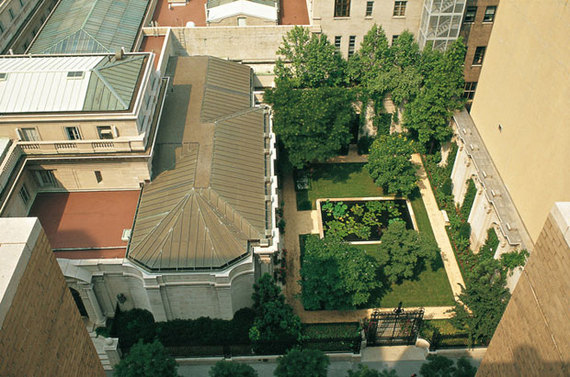
New York’s Frick Collection is going back to the drawing board once again, abandoning its plans to build a six-story addition in place of a historic viewing garden. The museum’s board meets today for a formal vote.
“It just became clear to us that it wasn’t going to work,” an anonymous museum official told the New York Times, acknowledging the widespread opposition to the proposed changes to the institution, housed in Henry Clay Frick’s historic Gilded Age mansion. “There was just a number of voices out there, and we heard them.”
The Davis Brody Bond renovation plan, first announced a year ago this month (see Will Massive Expansion Destroy Beloved Frick Museum?), now joins unfulfilled expansion plans from 2001, 2005, and 2008 in being scuttled. However, in 2012, the museum did successfully convert an outdoor portico into an interior room.
A rendering of the proposed Frick expansion.
Photo: Neoscape Inc.
In this era of massive museum expansions, with a brand-new Whitney Museum of American Art and big plans in the works at the Metropolitan Museum of Art and the Museum of Modern Art in New York (see Does the New Whitney Museum Herald a Golden Age for New York Institutions?, Metropolitan Museum Offers $250M Bond Deal to Back Expansion, and MoMA Skyscraper Set to Rise with $85 Million Air Rights Purchase), it is no surprise that the Frick feels pressure to compete with its glossy, ballooning counterparts.
artnet News was among the first to advocate for the preservation of the garden as an important green space and visual respite in the neighborhood (see Let the Frick Be). Not long thereafter, Cultural Landscape Foundation (CLF) founder and president Charles A. Birnbaum took to the Huffington Post to inform readers that the garden was the only surviving New York work from British landscape architect Russell Page.
In late July, New York Times architecture critic Michael Kimmelman also voiced his disapproval of the plan, calling the garden “one of those little New York treasures,” and “model of precision and proportion, a revelation and breather on the street.”
Frick director Ian Wardropper contended that the garden had been planned as a temporary placeholder until an addition could be built. The museum’s cause took a hit when Birnbaum uncovered a museum press release from 1977 describing the planned Page garden as a permanent addition to the institution’s grounds (see Frick Garden Was Meant to Be Permanent).
The Frick’s Russell Page Garden.
Photo: Wally Gobetz via Flickr.
The movement to preserve the garden and the Frick’s perceived “jewel box” character picked up steam with the formation of Unite to Save the Frick on Change.org. The coalition includes Robert A.M. Stern, Maya Lin, and former New York City Landmarks Preservation Commission heads Roberta Brandes Gratz, Stephen F. Byrns, and Beverly Moss Spatt (see “Save the Frick” Petition Racking Up Signatures).
CLF even placed the garden on its annual Landslide list, which hopes to preserve threatened land-based art sites (see Are These 11 American Art Landscapes Worth Saving?).
Everett Fahy, the Frick’s director 1973 to 1986, also became a vocal detractor of the expansion (see Former Frick Director Speaks Out Against Expansion Plan), telling Bloomberg, “It’s awful. That intimacy and atmosphere would be lost.”
An architectural plan for the Frick Collection expansion.
Photo: courtesy Davis Brody Bond.
Rather than engage in a prolonged legal battle, the museum has decided to back down.
“After months of public dialogue and thoughtful consideration and weighing the potential for a protracted approval process against the Frick’s pressing needs, the board of trustees has decided to approach the expansion plan in a way that avoids building on the garden site,” Wardropper relayed in a statement.
The director went on to promise that the museum would develop a new plan that would still convert the museum’s second floor into galleries and provide additional exhibition space, classrooms, and research and conservation facilities.
“Preserving the unique residential character and intimate scale of the Frick will remain our top priority,” Wardropper noted.
“Sanity has actually prevailed!” Birnbaum said in a phone interview with artnet News. “We hope that the garden will be renewed, that information about the garden will be put back on the museum website, and that the Frick will recognize the legacy that they have inherited.”